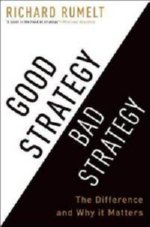
In his new book Good Strategy / Bad Strategy: The Difference and Why It Matters (July 2011), Richard Rumelt highlights the hallmarks of bad business strategy and recommends a framework for developing good strategy. We piggyback on his concepts to highlight the role that structured change plays in implementing good strategies.
Bad Strategy
According to Rumelt, the key hallmarks of bad strategy can be condensed to four points:
- Failure to face the problem. A challenge or issue that is not well-defined.
- Mistaking goals for strategy. A desired outcome without a plan for how to get there.
- Bad strategic objectives. A long list of things to do, often mislabeled as strategies or objectives.
- Fluff. Superficial claims that restate the obvious and do not provide direction.
There are many reasons for bad strategy. Two of the most common reasons are: 1) the inability to choose and 2) template-style planning. Strategy involves focus and, therefore, choice. And choice means setting aside some goals in favor of others. Often leaders do not focus on the one or two key “pivot points” that will give them the leverage needed to drive their strategy. The template-based approach involves filling in the blanks for vision, mission, values, and strategies. Often this concensus-driven exercise results in statements of the obvious presented as if they were decisive insights. When the hard work is not done, weak strategy is the result. Unfortunately, this template-style planning has been enthusiastically adopted by corporations, school boards, university presidents, and government agencies.
Good Strategy
Good strategy, in contrast, works by focusing energy and resources on one, or a very few, pivotal objectives whose accomplishment will lead to a cascade of favorable outcomes. It also builds a bridge between the critical challenge at the heart of the strategy and action—between desire and immediate objectives that lie within grasp. Thus, the objectives that a good strategy sets stand a good chance of being accomplished, given existing resources and competencies.
Good strategies have a basic underlying structure:
- A diagnosis: an explanation of the nature of the challenge. A good diagnosis simplifies the often overwhelming complexity of reality by identifying certain aspects of the situation as being the critical ones.
- A guiding policy: an overall approach chosen to cope with or overcome the obstacles identified in the diagnosis.
- Coherent actions: steps that are coordinated with one another to support the implementation of the guiding policy.
The Role of Structured Change
In developing the coordinated steps that are part of the “coherent actions,” leaders should bear in mind that the strategy development and implementation effort is also a major change initiative. This is because new or revised strategies – at least the good ones – inevitably have far-reaching implications for the organization’s stakeholders, how priorities are set, and how business is conducted. To this end, leaders should ensure that a structured approach to managing change is incorporated into the strategy process.
While there are many actions leaders should take to effectively lead change, (in keeping with Rumelt’s concept of focusing on the few, pivotal objectives) involvement of key stakeholders in the process will provide the most leverage. Specifically, leaders should look for ways to give important employee groups (specifically, those who are influencers) a voice/role in assessing the challenge, and then helping to design and implement the strategy. Doing so will foster a sense of co-ownership among stakeholders for the changes that they will eventually need to adopt as a result of the strategy.












